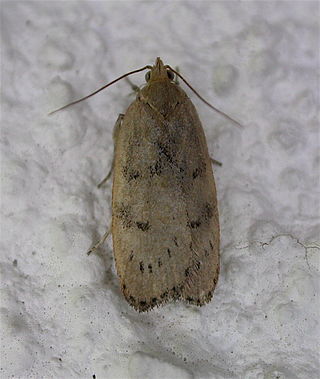
Phaeosaces coarctatella is a species of moth in the family Oecophoridae. It is endemic to New Zealand and can be found throughout the country. The preferred habitat of this species is native forest however they can also be found in domestic gardens. Larvae shelter in hollow twigs or under bark and emerge at night to browse on lichens. They pupate within their shelter. Adults are on the wing from September to January and are variable in their appearance. They vary both in colour, from reddish brown to a greenish yellow shade, and also in the extent of the black marking on their forewings. They are nocturnal and are attracted to light.
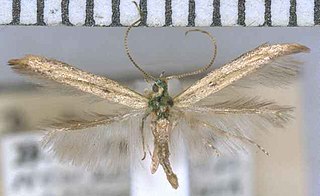
Batrachedra arenosella, the armoured scale eating caterpillar or the coconut moth, is a species of moth of the family Batrachedridae. It was first described by Francis Walker using specimens collected in Auckland, New Zealand. It has been hypothesised that the New Zealand moth may contain two distinct species. As well as the moth species in New Zealand, this name has been applied, perhaps incorrectly, to moths found in India, Indonesia, the Malay Peninsula, and Réunion, as well as in Australia, from the Northern Territory and northern Queensland to New South Wales and South Australia.

Izatha copiosella is a moth of the family Oecophoridae. It is endemic to New Zealand, where it is found on the south-eastern parts of the North Island and throughout the South Island except the West Coast. Larvae are found in dead wood and are likely to use kōwhai species as hosts. The adults are night fliers and are attracted to light. They are on the wing in January and February.

Heterocrossa adreptella is a moth of the Carposinidae family. This species was long considered the New Zealand raspberry budmoth however this was a taxonomic misinterpretation of the type material used to describe this species. This error was corrected in 1988 with the New Zealand raspberry budmoth giving its own species name Heterocrossa rubophaga. H. adreptella is endemic to New Zealand and has been collected in the Wellington Botanic Garden and been observed resting on mānuka branches.

Heterocrossa contactella is a species of moth in the family Carposinidae. It is endemic to New Zealand and can be observed in both the North and South Islands. The preferred habitat of this species is native forest and scrub, especially where Leptospermum shrubs are found. Adults are on the wing in December and January.

Pyroderces apparitella is a species of moth in the family Cosmopterigidae. It is endemic to New Zealand and has been observed in the North Island where it is regarded by some as being not common. The preferred habitat of this species is native forests and residential gardens. Adults are on the wing in December and January and the species is attracted to light.

Pasiphila muscosata, the emerald pug moth, is a moth in the family Geometridae. It is endemic to New Zealand and has been found in the North, South and Stewart Islands. The larvae of this species are known to be present in January and live on Muehlenbeckia species including Muehlenbeckia australis. The larvae tends to be brown but it is variable in both colour and markings. The larvae of this species pupates in a loose cocoon on the ground and adult moths emerge in September. Adults are commonly on the wing until the following May. Although adults tend to be a deep emerald green colour this species is again variable and there is also an orange-yellow variety as well as intermediate forms. Adults are attracted to light and often rest during the day on tree trunks.

Agriophara colligatella, also known as the Olearia skeletoniser, is a moth of the family Depressariidae. It is endemic to New Zealand and is found on both the North and South Islands. This species inhabits native scrub. Larvae feed on the leaves of species in the genus Olearia during the months of November and December. They then pupate amongst the old flowers and leaves of their host plant. Adults have been observed on the wing from August to September but are most common in January. It has been hypothesised that this species overwinters as an adult as it has been observed on the wing in late autumn and early winter. Adults are attracted to light.

Gadira acerella is a moth in the family Crambidae. It was first described by Francis Walker. It is endemic to New Zealand and is found throughout the country. The species inhabits native forest from sea level up to subalpine altitudes. Larvae are assumed to feed on lichen or moss. Adults are on the wing from October until March, are active at night and are attracted to light. This species is distinctively patterned and coloured and is said to resemble a bird dropping at rest. The colouring also assists to camouflage the moth when it rests against lichen.
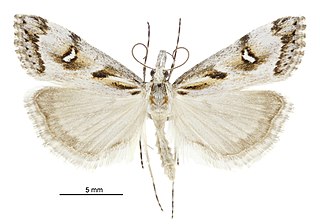
Gadira leucophthalma, the beaked moss moth, is a moth in the family Crambidae. It is endemic to New Zealand. It is found in the south eastern side of the South Island down to Banks Peninsula. G. leucophthalma inhabits the foredunes of coastal areas. The larval host is unknown but it has been hypothesised that the larvae feed on moss. The adult moths are day flying although some specimens have been trapped at night via light traps. Adults are commonly on the wing from March to April. This species has been classified as Nationally Vulnerable by the Department of Conservation.

Glaucocharis auriscriptella, also known as the yellow silverling, is a moth in the family Crambidae. It was first described by Francis Walker in 1864 and is endemic to New Zealand. This species can be found in the North, South, Stewart and Great Barrier Islands. The preferred habitat of this moth is lowland and subalpine native forest as well as wetlands. The larvae feed on moss. The adult moth is day flying and is on the wing from November to February. It can be observed in colonies and can be attracted to light at night. This species likely has only one generation per year.
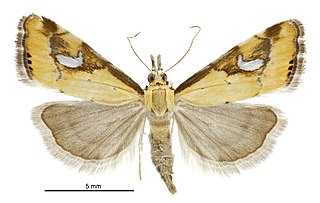
Glaucocharis lepidella is a species of moth in the family Crambidae. It was described by Francis Walker in 1866. It is endemic to New Zealand and is found in both the North and South Island. The species inhabits lowland to subalpine native forest. Larvae may feed on mosses. Adults are on the wing from November to February and are attracted to light.

Asaphodes abrogata is a moth in the family Geometridae. It is endemic to New Zealand and can be found from the central North Island as well as the South Island. This species is inhabits open country at altitudes of between 2000 and 4000 ft. Larvae have been reared on Plantago species including Plantago coronopus. It has been recommended that Plantago raoulii be planted to attracted this species. Adults are on the wing in February and March.

Atomotricha is a genus of moths of the family Oecophoridae. The species in this genus are endemic to New Zealand.

Physetica temperata is a species of moth of the family Noctuidae. It is endemic to New Zealand and found in the North Island and the top of the South Island in coastal areas. P. temperata is unlikely to be confused with other species in its range, even though it is not distinctively patterned. It is possible that males might be confused with males of P. homoscia but this latter species is much larger. P. temperata can be distinguished from P. caerulea as the former species has forewing veins that are marked black and a chequered forewing fringe. The adults of this species are on the wing from September to March. The life history of this species has not been well documented although it is thought that larval host species is Ozothamnus leptophyllus.

Tingena apertella is a species of moth in the family Oecophoridae. It is endemic to New Zealand and can be found in both the North and South Islands. Adults are on the wing from November to January and the species is common in beech forests at approximately 2000 ft. At rest on the ground this species appears very similar to a yellow beech leaf.
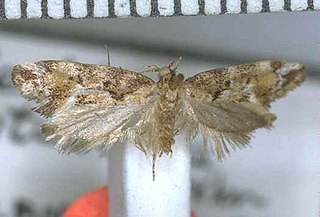
Tingena contextella is a species of moth in the family Oecophoridae. It is endemic to New Zealand and has found in the North and South Islands. The larvae of this species feed on leaf litter.
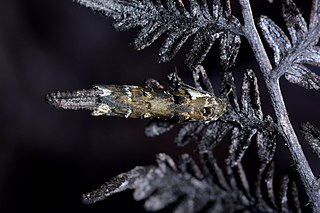
Trachypepla conspicuella is a species of moth in the family Oecophoridae. It is endemic to New Zealand and is found in both the North and South Islands. It is similar in appearance to its close relative T. euryleucota but tends to be paler. Its colouration imitates bird droppings. Larvae feed on leaf litter. Adults of this species are on the wing from November to February and have been observed resting on fences and walls.

Trachypepla contritella, the Kiwi Enigma, is a species of moth in the family Oecophoridae. Originally endemic to New Zealand this species can be found throughout that country. However, from 2012 this species has been also been recorded in the United Kingdom. The preferred habitat of T. conritella is New Zealand native forest and larvae of this species are litter leaf feeders. Adults are on the wing from November to February in New Zealand and are attracted to light.
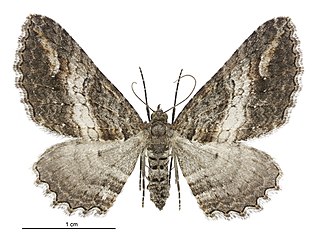
Horisme suppressaria is a moth of the family Geometridae. This species was first described by Francis Walker. Currently the taxonomy of this species is uncertain and as a result this species is also known as Horisme (s.l.) suppressaria. The species is endemic to New Zealand and has been observed in both the North and South Islands. The larval hosts of H. suppressaria are species in the genus Corokia including Corokia cotoneaster.




















